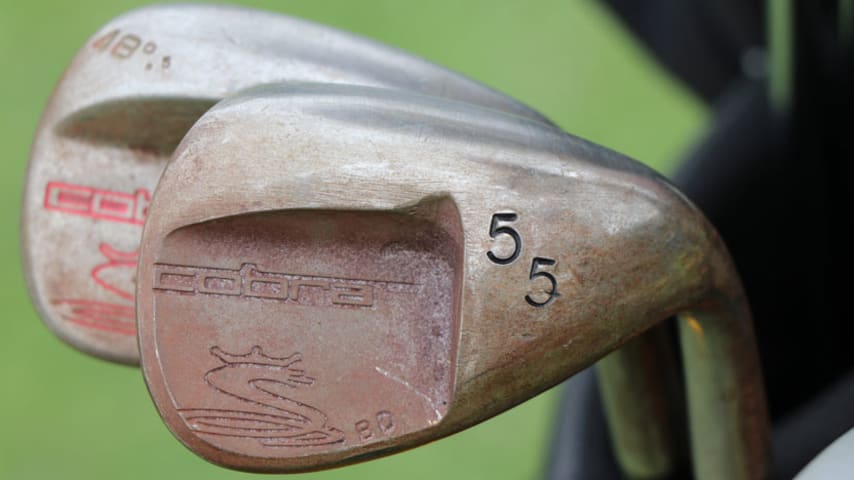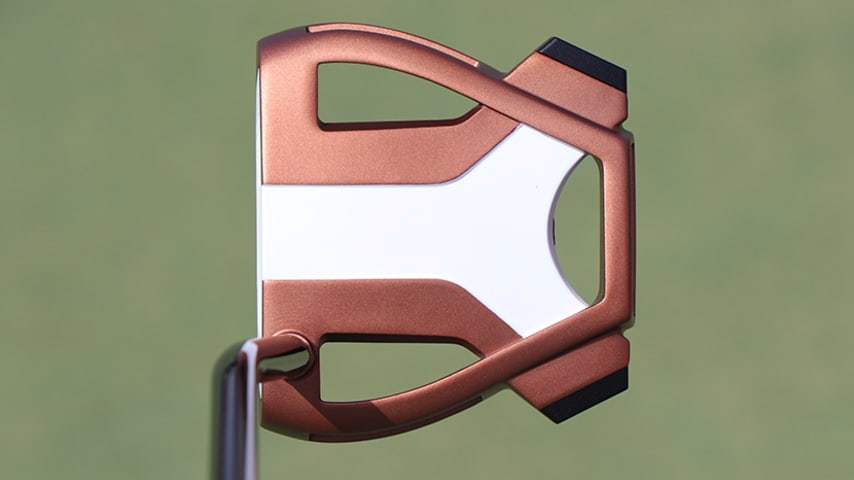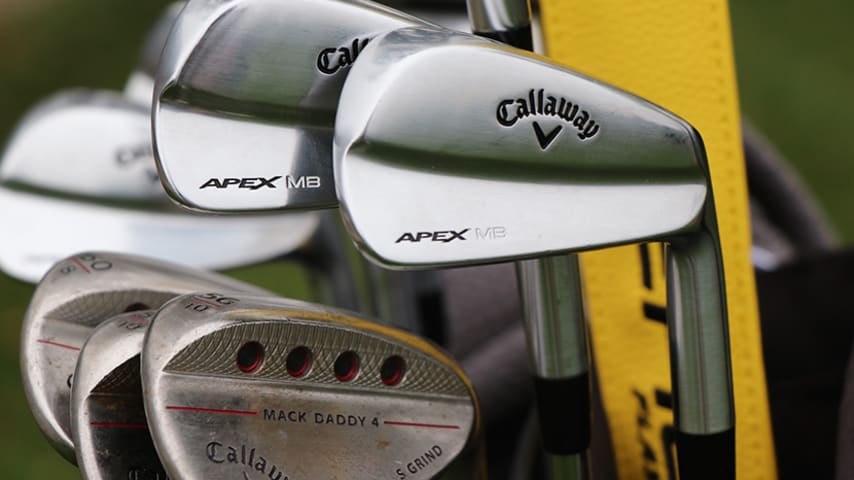The story behind Bryson DeChambeau's custom Cobra wedges, why they work, and how much time they take to build
8 Min Read

Why they work, and how much time they take to build
Why they work, and how much time they take to build
Take one look at Bryson DeChambeau’s new custom Cobra wedges that he’s been using throughout 2019, and you’ll notice something is really different. Wedge shapes throughout the years, especially with retail clubs made for high-handicappers, have had outlandish designs. Think about the Alien wedge, or even the Callaway Sure-Out; wedges made with extremely wide soles and high degrees of bounce. But, DeChambeau’s new wedges are even wildly different from those, let alone the classic wedge shapes you typically see in TOUR bags.
Some wedges in recent years – think Nike’s Engage Toe Sweep wedges – have moved weight to the toe in order to move center of gravity (CG) more toward the center of the face. Those toe-heavy designs make sense because, given the nature of wedge shapes, which have heavy hosels and heel sections, they tend to have a heel-ward center of gravity. DeChambeau’s wedges defy this logic, however. Instead, DeChambeau’s wedges have an extremely heavy heel section on their back cavities.
As PGATOUR.COM learned from Ben Schomin, Cobra’s Tour Operations Manager and the man who built the clubs for DeChambeau, the custom heel-weighted wedges have little to do with CG and everything to do with face deflection and consistency.
Below, Schomin explains in great detail why the wedges work for DeChambeau, and just how long it takes to build one of these wedges. Enjoy our full Q&A with Schomin about DeChambeau’s custom Cobra wedges.
PGATOUR.COM: Obviously Bryson’s wedges are made to be very heavy in the heel. Can you explain why you built them that way and how it benefits him?
Schomin: With the length of his wedges, like the length of his lob wedge is – our standard length is 35 (inches), which is pretty standard across the board for most manufacturers – his is 37.5 (inches). So it’s 2.5 inches longer. He can swing it faster … since he can swing the wedges faster, it’s unlikely the ball is able to stay on the lower grooves and come out a little lower and spin like he wanted do. It’s got more likelihood to roll up the face, which leaves him with hitting one at a great spin rate, say 11,000 rpm and being able to flight it stop it like he wants, or he’ll get one that launches 3 or 4 degrees higher and spins it 7,000 (rpm). It’ll still come down steep so it stops, which is why he’s been able to make it work for so long, but the consistency of it is just tough, as you can imagine. At this level, guys expect to hit wedges inside 10 feet at 100 yards or 80 yards. So, part of the thought was that speed. Then obviously at impact there’s face deflection, because of where the shaft is, the face wants to open. The easiest analogy to relate it to is a driver. If you want the driver to close more you put more weight in the heel, if you want it to stay open at impact you put more weight in the toe. That’s basically the same scenario that I was working on. Like, will this work in a wedge by bulking up the heel? Can I get it to not deflect open as much? Is there a way we can get the ball to stay lower on the face longer and create more consistency?
I think it was Tiger’s event in the Bahamas when we first tested [heel-heavy] 55 and 60 (degree wedges) with him. He was pretty stoked because it worked, especially chipping he felt better hitting like three-quarter shots. It worked. So I’ve done a couple sets, and basically added more weight to see if that would help, and, is there a point of no return where it just doesn’t feel right? Like, where he’s at now, he’s got quite a bit of weight in the heel, upwards of 35-40 grams just in the heel. From the way wedge design goes every year, or has gone in the last few years, it’s kind of counter intuitive, but for him it seems to be working. A lot of the things he does are opposite of what everyone else does. So it’s kind of just par for the course.
I was going to say, with Rickie’s wedges you’ve always put Tungsten toward the toe I think, and a lot of golfers put extra weight in the toe. But with Bryson, you’re putting so much extra weight in the heel, does that do anything to CG?
Yea, those clubs inherently have a CG that’s more heel-ward anyways just because of their shape and the longer hosel. So like with Rickie we put [extra weight] in the toe and it actually ends up going quite a ways because [CG] ends up being in the middle of the golf club. But it’s not in the toe just to have it in the toe. It’s just because that’s the best and easiest place to put it to add that kind of weight that we need to add. So it’s not that we’re putting that in Rickie’s to try to get the face to deflect. It does move CG for him more toward the center, which isn’t a bad thing. In Bryson’s case it does move [CG], but it doesn’t move it to where you have to hit it on the hosel to center strike it.
So far it’s just something we continue to work on and evolve with. I’ve got some other ideas we’re working on now, and I’ve tested it with other players out here. I tested one with Rickie, tested it with Lexi, a few other players that have tried. Some players notice it, some don’t. Some can’t tell the difference. It’s one thing to do it at 37.5 inches, but does this really make a huge difference? Obviously at the longer length it does, but will it have that effect for us at, say, 35 inches. I know it’s working for [DeChambeau], now will it translate to the rest of us? It’s kind of what we do out here anyway, it’s like a big R&D project.
Can you talk about the process of how you actually make the wedges, and the work that goes into that in terms of hours spent?
Yea, actually it’s pretty time-consuming. So the weight in the heel, I just lay weld bead. That itself is a little bit time-consuming because you can’t just lay it all and let it basically cool down. It creates a lot of heat. I don’t want to anneal it, or harden it anymore than it is. Also, I don’t want the head to warp at all just because of the high heat. So, I only do like one or two short beads at a time, just to try to make sure that doesn’t happen. I’ve gotten some special fixtures made up to draw heat away at the same time. So that takes some time in itself just to get the weight on there. Then once it’s on there, taking it off and grinding it and shaping it, and just trying to make it look decent. I mean, if you just lay a bunch of weld bead on it’s not going to look very pretty. But, for a test purpose it’s fine. I’ve done it before and it’s not a big deal. But I still want to make it look good. So between that and… if you notice in the middle there’s kind of a hard-line edge. So that’s actually done on an end-mill, which, that’s another probably solid hour just to flatten it out and clean it up, and make it look like something that was almost cast in or forged in.
Every club is a few hours, for sure. Normally it doesn’t take that long to grind a wedge and stamp some initals on it and paintfill it. But that’s been his M.O. And a lot of cases we’ve ended up going to extremes, whatever that happens to be. So with the wedges it’s the same deal. We’re going down that road of, how much weight is too much weight in the heel where it doesn’t feel right or it’s not working? So far it does seem to be working for him. It’s more consistent with, like I said those three-quarter shots. But we’re going to continue working, maybe make something that’s ultimately the same from a physics standpoint, but the application of it is a little different.
Is it fun for you to work on these kind of projects with Bryson?
Yea, totally. Everything with him in a lot of ways … although driver obviously is very similar to what’s standard for most golfers, but the irons, the wedges, all that stuff has been and continues to be a challenge of sorts. That part, it is fun. It’s trying, and it’s challenging and really racks your brain; like yesterday we did some work on the range. It’s trying to think about how to approach it differently, what’s going to work for him. We’ve got a laundry list of things we tried in the past that worked, some kinda worked, and some didn’t work. There’s definitely a lot more fails than successes. You just put a lot of time and effort into something, and it stinks when it doesn’t work, but onto the next thing, or onto hopefully tweaks that are going to work for him. But overall it’s good. It is a lot of extra work (though).






